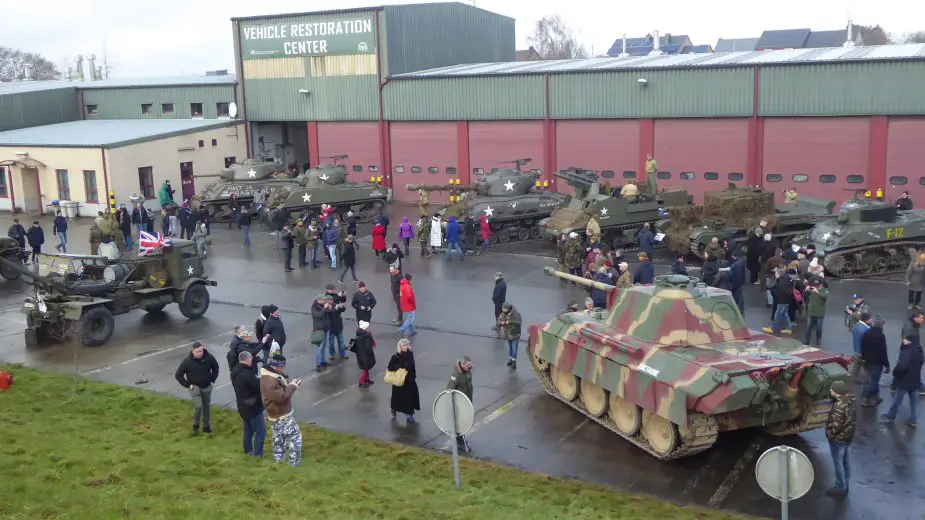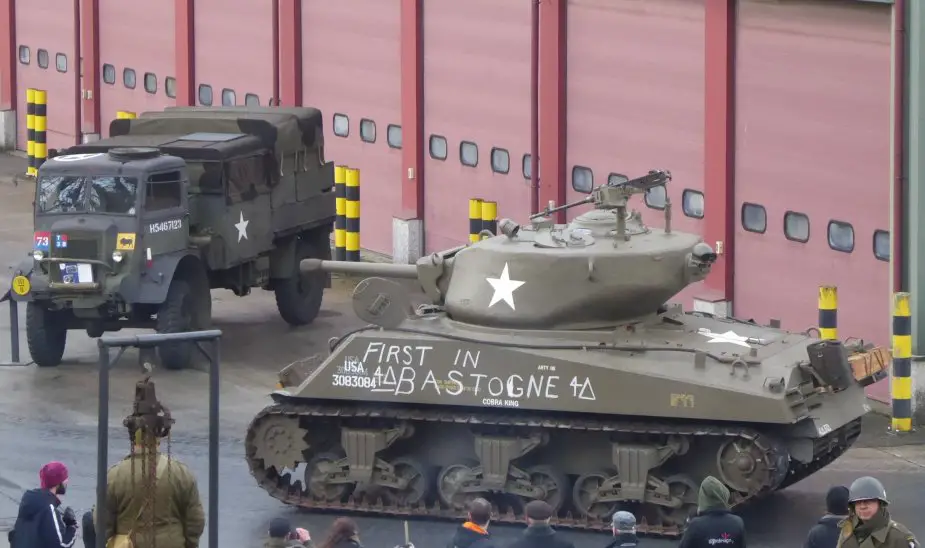Military and civilian dignitaries from Europe and the United States were in Belgium on Sunday 15 and Monday 16 December to mark the anniversary of one of the most important battles of World War II: the Battle of the Bulge. "There are times we must say, 'No,'" King Philippe of Belgium said in Bastogne, Belgium. "'No' to the extreme evil perpetrated by a hateful ideology. This is what we did together 75 years ago." The Belgian people remember their American liberators, the king said, pointing to six veterans of the battle who were attending the ceremony. Jim Garamone reports on Defense.gov.

Military and civilian dignitaries attend a ceremony marking the 75th anniversary of the Battle of the Bulge at the Mardasson Memorial in Bastogne, Belgium, Dec. 16 2019 (Picture source: Bruno Fahy, office of the Belgian Prime Minister)
Defense Secretary Dr. Mark T. Esper and Army Gen. Mark A. Milley, the chairman of the Joint Chiefs of Staff, attended the ceremony at Belgium's Mardasson Memorial. They met six veterans of the famed battle at the ceremony. The battle marked the second time in World War II that Nazi forces stormed through the Belgian Ardennes forest. In May 1940, the first attack broke through and resulted in the British being chased from Europe and France being defeated.

Defense Secretary Dr. Mark T. Esper and Army Gen. Mark A. Milley, the chairman of the Joint Chiefs of Staff, visit Bois Jacques — a wooded battlefield — in Bastogne, Belgium, Dec. 16, 2019. The visit was part of a U.S. delegation’s tour of the region to observe of the 75th anniversary of the Battle of the Bulge. Never for decades had such a large official delegation come to Bastogne (Picture source: Army Sgt 1st Class Chuck Burden, DOD)
In 1944, the Nazis' tanks ran into the U.S. Army. The battle was the largest Army operation of the war. By its end in January, 10,733 Allied soldiers were dead, 42,316 had been wounded and 22,636 were missing in action.
The German attack began the night of Dec. 16, 1944, with a German artillery barrage followed by multiple Panzer divisions. It was a complete surprise to the divisions holding the line in the Ardennes. Hitler's vision was to split the Allied force and drive to Antwerp, Belgium. Adding to the Germans' advantage was the weather: Because it was cloudy and foggy, Allied planes could not fly.

In Hardigny, north of Bastogne, the Task Force Booth courageously waged harsh fights to slow down the German advance and so enable the 101st Airborne to Reach Bastogne where the division was surrounded, along with other unit remnants trapped in the city during their retreat. This battle was reenacted with the exceptional participation of 240 reenactors, German and U.S. WW2 vehicles (Picture source: Alain HENRY de FRAHAN)
The U.S. formations were splintered, and many units lost cohesion. Yet, many more stood their ground and fought until they were overwhelmed. Each battle delayed the German timetable and gave time for reinforcements to come in. One of those units was the 101st Airborne Division, which was rushed to Bastogne to stop the Wehrmacht (Germany's regular armed forces) and the Waffen-SS from taking that crucial road junction. The division, known as the "Screaming Eagles," was completely besieged by German forces and carried out one of the most heroic defenses ever recorded in history, Esper said at the Bastogne memorial.

The reenacted battle in Hardigny was overflown by a Piper L-4 Grasshopper manufactured in 1943 (Picture source: Alain HENRY de FRAHAN)
Esper and Milley stopped at the Bois Jacques woods outside the town of Foy, Belgium, to visit with current soldiers of the division from Fort Campbell, Ky. "This is our Gettysburg," Army Maj. Gen. Brian Winski, the commander of the 101st Airborne Division said as he spoke to Esper and Milley. The fight for Bastogne was crucial to the division and the Allied forces in Europe. The Germans called on the 101st to surrender, but the commander - then Brig. Gen. Anthony McAuliffe - just replied, "Nuts." "The American troops beat back repeated infantry attacks from all directions," Esper said. "News of their fierce defense quickly spread, boosting the morale of Allied forces all along the Western Front."
The history of the battle is full of superlatives. Tanks broke through to Bastogne on Dec. 26, 1944. The weather cleared, and allied aircraft ripped the German armor and supply lines.
But the real reason for victory wasn't the technology or the plan; it was the heroism and fortitude of American soldiers in the largest part of the front (and the British and Belgian SAS in the north). "The Americans who fought here were led by some of our most revered military leaders of the time, but it was ultimately the intrepid and indomitable spirit of the American soldier that fueled us to victory," Esper said: "In World War II, America was willing to commit everything we had to preserve freedom," the secretary continued. "And on this ground, where the outcome of the Battle of the Bulge hung in the balance, American troops forged an incredible victory that assured the Nazi regime's defeat."

The Vehicle Restoration Center located in Bastogne Barracks and depending on the World Heritage Institute encompassing the Royal Museum of the Army invariably performs a fantastic job in restoring, maintaining, displaying and operating WW2 vehicles, mostly battle tanks, half-tracks and wheeled armored vehicles but also soft-skin vehicles (Picture source: Alain HENRY de FRAHAN)

The "star" among all the battle tanks taking part in the celebrations was "Cobra King", a Sherman M4A3E8 "Jumbo" (nicknamed so because of its additional armor) commanded by Lt. Charles Boggess who broke the German lines to enter Bastogne on Dec.26, 1944. This tank has been wonderfully restored in working condition by the Vehicle Restoration Center (Picture source: Alain HENRY de FRAHAN)
The renowned "Musée des Blindés" located in Saumur, France, lent its Pz.Kpfw. V "Panther" for the celebrations (Picture source: Alain HENRY de FRAHAN)
The formidable historic convoy that would parade on the main street of Bastogne is forming at the edge of the city. Besides the numerous tanks either privately owned or deployed by the Wolrd Heritage Institute's Vehicle Restoration Center, there were two Pacific Car & Foundry M26 Dragon Wagon tank transporters and several half-tracks coming from France (Picture source: Alain HENRY de FRAHAN)
















